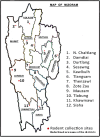Detection and molecular identification of scrub typhus vectors and pathogens from rice field rats, a traditional food item of Mizo tribes in Mizoram, Northeast India
- PMID: 40057725
- PMCID: PMC11889883
- DOI: 10.1186/s12917-025-04629-8
Detection and molecular identification of scrub typhus vectors and pathogens from rice field rats, a traditional food item of Mizo tribes in Mizoram, Northeast India
Abstract
Background & objectives: Orientia tsutsugamushi, a bacterial pathogen of scrub typhus, is transmitted to humans through the bite of infected chigger mites, and rodents are the natural hosts of the disease vector. The traditional practices of the tribal ethnic groups (Mizo) of Mizoram state such as capturing and consumption of rat meat collected from the agricultural fields could be one source of vector-disease transmission route. The present study aimed to detect and identify the pathogen of scrub typhus from vectors collected from rice field rats which were captured by farmers for meat consumption purposes.
Methods: One hundred and fifty-six freshly captured rice field rats were examined for ectoparasites. Detection and genotyping of O. tsutsugamushi from ectoparasites were done by real-time PCR and conventional PCR using species-specific primers. Rodents and ectoparasites were identified down to the species level using morphological and molecular techniques.
Results: Rice field rats were identified as Rattus tanezumi and Rattus nitidus. A total of 7973 trombiculid mites collected from 156 rats were identified as Leptotrombidium deliense, Leptotrombidium fletcheri, and Leptotrombidium chiangraiensis. Of these, 26 pools of L. deliense and 15 pools of L. fletcheri tested positive for O. tsutsugamushi, and the O. tsutsugamushi detected belongs to Kato and Karp-related genotypes.
Interpretation & conclusion: The present study reported the presence of O. tsutsugamushi-infected chigger mites in the captured rats (R. tanezumi and R. nitidus). Direct contact with the rats as a result of rat-eating habits may correspond to the high incidence rate of scrub typhus cases in Mizoram. Preventive measures are crucial for the control of scrub typhus disease in Mizoram.
Keywords: Orientia tsutsugamushi; Field rats; Mizo tribes; Molecular detection; Rodent hosts.
© 2025. The Author(s).
Conflict of interest statement
Declarations. Ethics approval and consent to participate: The present study protocol was reviewed by the Institutional Animal Ethics Committee (IAEC) of Pachhunga University College, Aizawl, Mizoram, India (vide IAEC No. PUC-IAEC-2021-A09, dated 05-07-2021), and approved for this study. Informed consent was also obtained from all the participants (Farmers) to donate their freshly captured (dead) rats for the present study. Consent for publication: Not applicable. Competing interests: The authors declare no competing interests.
Figures





Similar articles
-
Abundance & distribution of trombiculid mites & Orientia tsutsugamushi, the vectors & pathogen of scrub typhus in rodents & shrews collected from Puducherry & Tamil Nadu, India.Indian J Med Res. 2016 Dec;144(6):893-900. doi: 10.4103/ijmr.IJMR_1390_15. Indian J Med Res. 2016. PMID: 28474626 Free PMC article.
-
Occurrence of Orientia tsutsugamushi, the Etiological Agent of Scrub Typhus in Animal Hosts and Mite Vectors in Areas Reporting Human Cases of Acute Encephalitis Syndrome in the Gorakhpur Region of Uttar Pradesh, India.Vector Borne Zoonotic Dis. 2018 Oct;18(10):539-547. doi: 10.1089/vbz.2017.2246. Epub 2018 Jul 17. Vector Borne Zoonotic Dis. 2018. PMID: 30016222
-
Orientia tsutsugamushi dynamics in vectors and hosts: ecology and risk factors for foci of scrub typhus transmission in northern Thailand.Parasit Vectors. 2021 Oct 18;14(1):540. doi: 10.1186/s13071-021-05042-4. Parasit Vectors. 2021. PMID: 34663445 Free PMC article.
-
Scrub typhus ecology: a systematic review of Orientia in vectors and hosts.Parasit Vectors. 2019 Nov 4;12(1):513. doi: 10.1186/s13071-019-3751-x. Parasit Vectors. 2019. PMID: 31685019 Free PMC article.
-
Current status of mites and mite-borne diseases in India.J Vector Borne Dis. 2023 Jan-Mar;60(1):1-10. doi: 10.4103/0972-9062.361175. J Vector Borne Dis. 2023. PMID: 37026214 Review.
References
-
- Seong SY, Choi MS, Kim IS. Orientia tsutsugamushi infection: overview and immune responses. Microbes Infect. 2001;3(1):11–21. - PubMed
-
- Tilak R, Kunwar R, Wankhade UB, Tilak VW. Emergence of Schoengastiella ligula as the vector of scrub typhus outbreak in Darjeeling: has Leptotrombidium deliense been replaced? Indian J Public Health. 2011;55(2):92–9. - PubMed
-
- Lee HI, Shim SK, Song BG, Choi EN, Hwang KJ, Park MY, et al. Detection of Orientiatsutsugamushi, the causative agent of scrub typhus, in a novel mite species, Eushoengastiakoreaensis, in Korea. Vector Borne Zoonotic Dis. 2011;11(3):209–14. - PubMed
MeSH terms
LinkOut - more resources
Full Text Sources

